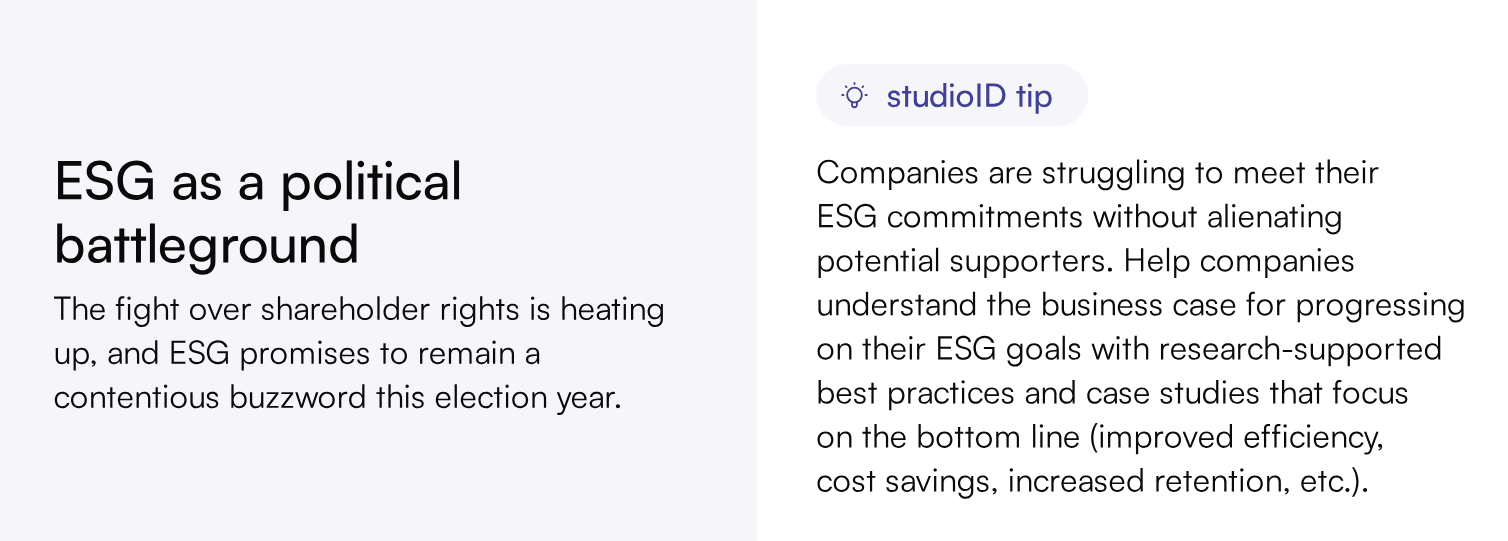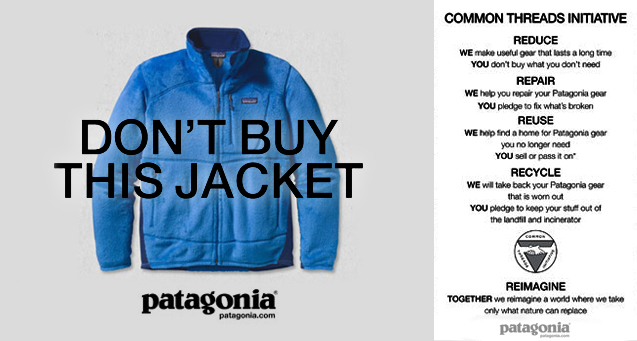Table of Contents
This election year, B2B leaders are grappling with challenges that span across technological disruptions, economic fluctuations, and increasing demands for sustainable and ethical operations. We’re here to help.
Drawing from exclusive research found in studioID’s 2024 Audience Snapshots, we’ve analyzed readership data from each of Industry Dive’s 37 vertical publications to reveal three concrete hurdles across industries — from marketing, HR, and retail to utilities, healthcare, cybersecurity, finance and far beyond.
Whether looking for insights into your direct field or one that’s adjacent, these reports are jam-packed with vital stats, takeaways, and tips that any marketing leader would be wise to know. Read on to understand the current state of affairs, see how top brands are faring, and take away key insights from industry strategists.
AI Disruption
Artificial intelligence is a double-edged sword for B2B sectors this year. On the bright side, it offers unprecedented opportunities to save time, money, and labor — like streamlining supply chains, enhancing strategic decision-making, and optimizing financial pattern recognition. But the rapid adoption of AI technologies has also led to a dark side that includes security and privacy issues, authenticity concerns, and regulatory compliance challenges.
This presents a need for rigorous data validation that addresses accuracy and bias as well as a strong compliance framework to navigate the regulatory landscape. But most importantly, transparency in AI processes is needed to alleviate privacy and authenticity concerns. And to do that, stakeholders must be fully informed about how internal AI systems operate and make decisions.
While the struggle to showcase the ROI of AI-related investments continues, so does the pressure to incorporate the tech across all facets of business. As a result, it’s vital to invest in employee education and establish organizational policies and compliance standards. Why?
“[Those] who don’t invest in comprehensive AI training programs for their teams will lose out on opportunities to leverage these powerful, emerging technologies effectively,” according to CX Dive’s Audience Spotlight.
Emphasize the integration of AI-powered solutions to enhance customer interactions while underscoring the importance of maintaining a human touch.
Brand Campaign Spotlight: Microsoft Copilot’s City Companion
For a company like Microsoft, it’s important to be as clear as possible when it comes to the ethical integration and capabilities of AI — inside and out. To introduce its audience to its new generative AI tool, Copilot, the brand has released a video series highlighting how the tech can help anyone have a better day, no matter what they may be up to. With an unscripted, casual, human-centered approach, City Companion helps build trust and transparency around an otherwise murky topic that still has a lot of people on their toes and will for some time.
Bottom Line
As leaders focus on harnessing AI to revolutionize operations, the tech is here to stay in 2024 — and so is the fanfare. “Generative AI is creating new possibilities for marketing leaders – but the media frenzy makes it hard to separate the substance from the hot air,” according to the Marketing Dive Audience Snapshot.
Instead of falling for the hype (or deep fakes), take a more pragmatic approach to AI and genuinely guide your audience through the new territory. “Marketing leaders need even-keeled, realistic assessments of the technology’s current sweet spots, limitations/cautions, and actual ROI.
Remember: this is an incredibly bloated topic, so if you’re going to add to the noise, make sure you’re taking a fresh perspective or offering new intel.
Economic Ups and Downs
Although inflation rates have shown signs of cooling, high operational costs and shifting consumer spending behaviors present another big challenge for B2B leaders this year. And with the cost of living rising more quickly than people’s salaries, folks have cut back on discretionary purchases and their willingness to pay is dwindling.
At the same time, potential interest rate cuts and increased merger and acquisition activity can offer business leaders new avenues for growth. But in the face of high labor costs and increased business expenses, accelerating digital transformation efforts can help companies stay competitive and responsive to economic changes. Transitional circumstances aside, an enhanced brand presence online and across social is key to maintaining profitability during downturns as well as capitalizing on growth during economic recoveries.
Brand Campaign Spotlight: Hubspot’s Social Media Shift
View this post on Instagram
When executed well, budget-friendly campaigns are always a good idea — whether or not the market is booming. Leveraging low-cost trends in content creation, we’ve recently seen a slew of B2B brands hop on the low-fi content trend across social media, complete with work-related memes, simple graphics, and selfie videos. None stands out more so in the B2B space than Hubspot’s seemingly sudden shift to memeified posts. Written with a humorous and friendly tone, Hubspot’s posts are a refreshing break from nonstop shop talk and economic worries.
Bottom Line
Stay human and try to maintain a sense of humor, if not full-out optimism. You might also consider a potential brand collaboration, but either way, be sure to tune in to the current moment to strike the right tone with your audience and internal stakeholders. “The ripple effects of the pandemic are still impacting…teams, leaving them with fewer resources and more responsibilities,” says CIO Dive’s Audience Spotlight.
While leaders are cautiously optimistic, to keep resonating with the Great Resignation, don’t sleep on employee engagement and retention. “Highlight how to combat short staffing and burnout among executives with real time insights on how to automate tasks to take the pressure off of staff.” And for those looking to go the extra mile?
Address how CIOs can use their data, both for security purposes as well as marketing and customer experience purposes.
Environmental, Social, and Governance Needs
Alongside a volatile economy, heightened geopolitical tensions continue to impact financial markets, institutions, and infrastructure. That’s why today’s consumers and regulators expect companies to demonstrate commitment to sustainability, strong governance, and genuinely ethical practices.
Integrating ESG goals and actions into your company’s corporate strategy is crucial for boosting transparency and accountability. This can include everything from reducing emissions and implementing greener packaging solutions to fostering diversity and demonstrating corporate social responsibility — as long as it’s genuine.
“With brand trust at an all-time low, the everyday consumer has grown skeptical — often outright dismissive — of what they perceive as ‘greenwashing,’” says Melissa Mattoon, a Senior Strategist at Industry Dive.
In an increasingly uncertain time, brands that can solve a problem or offer a meaningful promise of hope, safety, or security amid the chaos have a better chance of forming a lasting connection.
Brand Campaign Spotlight: Patagonia’s Common Threads
With ESG efforts that enhance brand loyalty among consumers while setting a high standard for operational excellence, Patagonia’s dedication to social responsibility makes it a standout example in the industry. Often considered the gold star of corporate sustainability, the company has long made waves for its dedication to environment and conservation, but — with a focus on achieving zero waste and reducing carbon emissions — it’s the brand’s commitment to a circular business model with the Common Threads program that truly sets them apart.
Bottom Line
Today, folks expect more from the businesses they choose to buy from, and “future-focused brands see the writing on the wall: brand trust will increasingly be assessed on their commitment to building a better future,” says Mattoon.
Truly effective strategy goes beyond the surface, to not just talk about change, but actively drive it.
And if you think greenwashing is an option, think again. “Leaders need to be transparent, but their narratives and promises must be backed by action,” according to the ESG Dive Audience Spotlight. To break through the noise, “Guide leaders away from greenwashing by showing them examples of companies that have been called out and/or fined for making empty promises. More importantly, show them how you can help them accurately meet reporting requirements and chart a path toward meaningful impact.”
People inside and outside of your organization expect you to stand for what’s right and show them how you’re bettering the world. In 2024, get ready to deliver.
![]()









